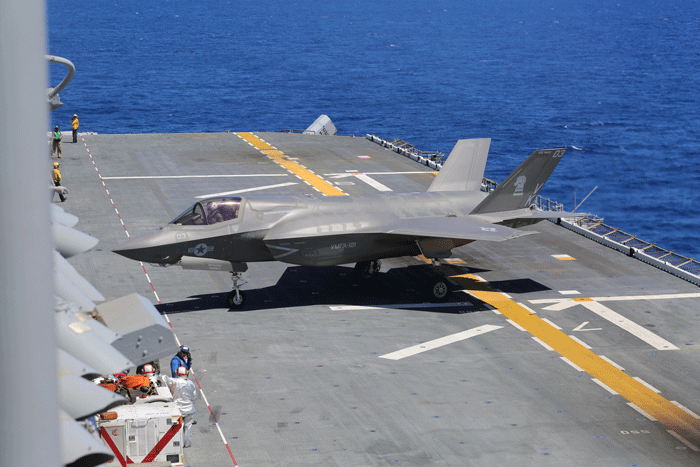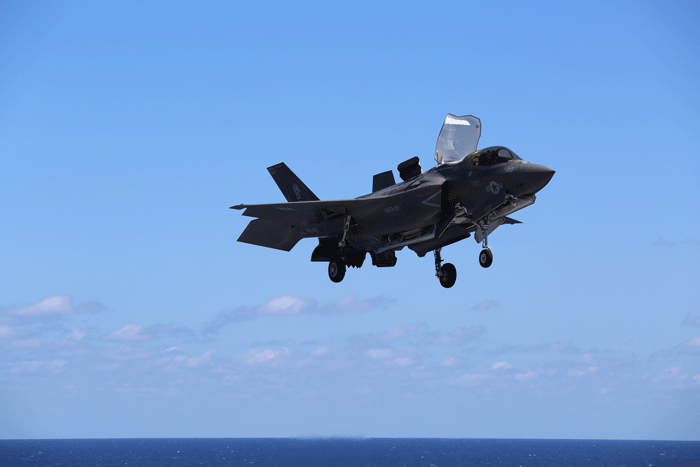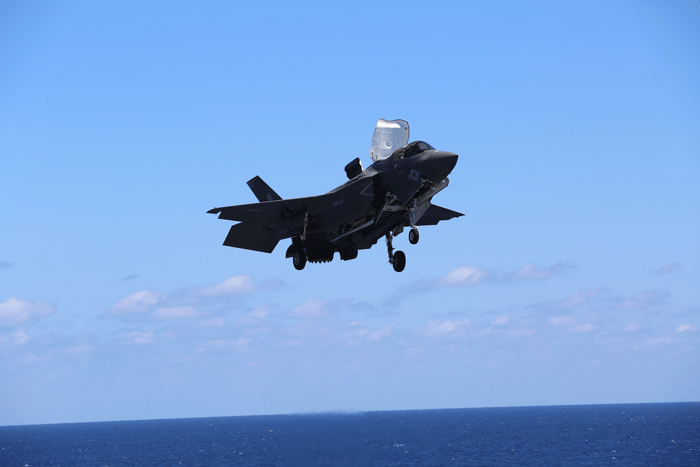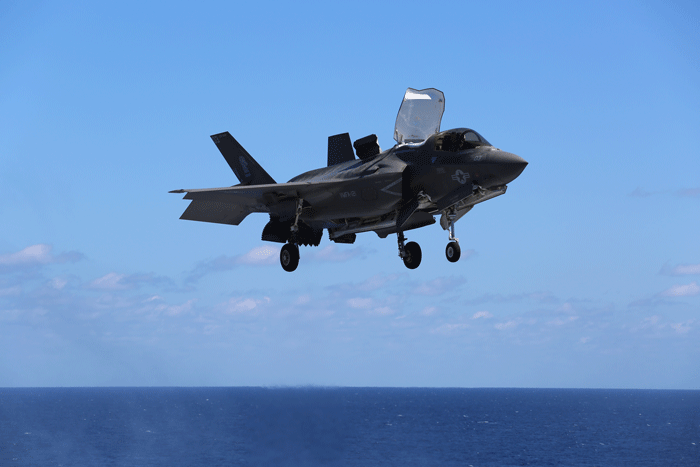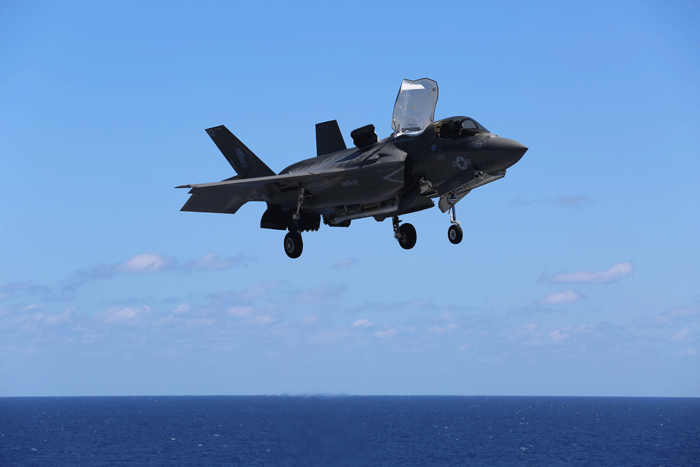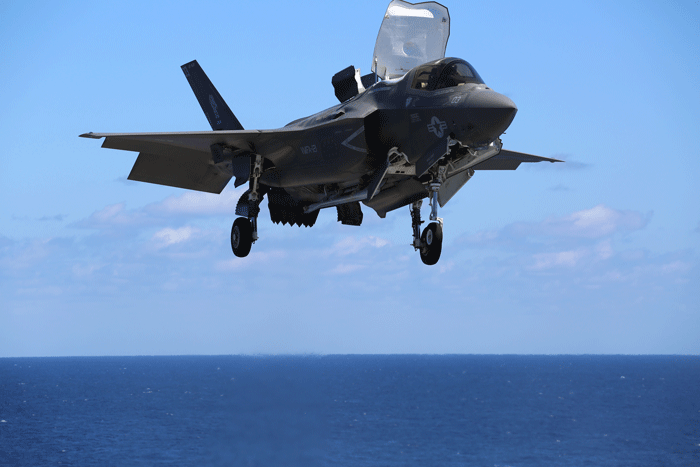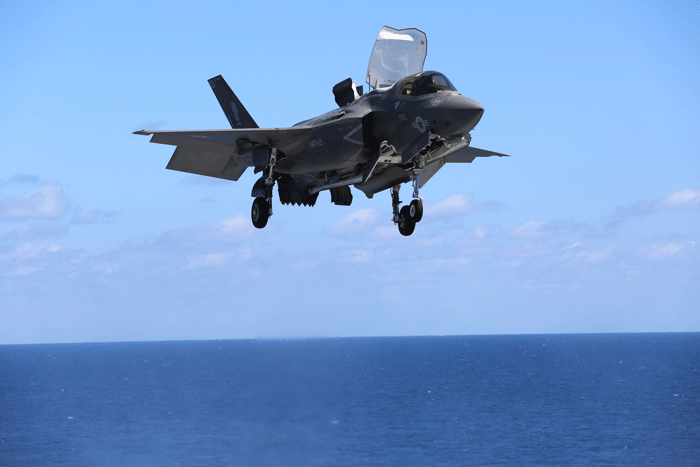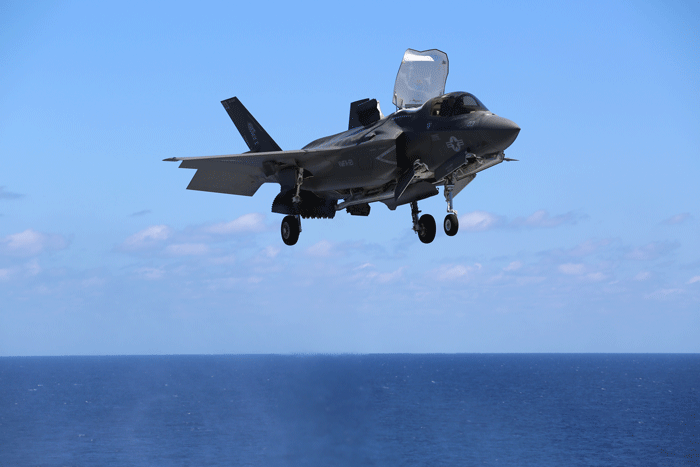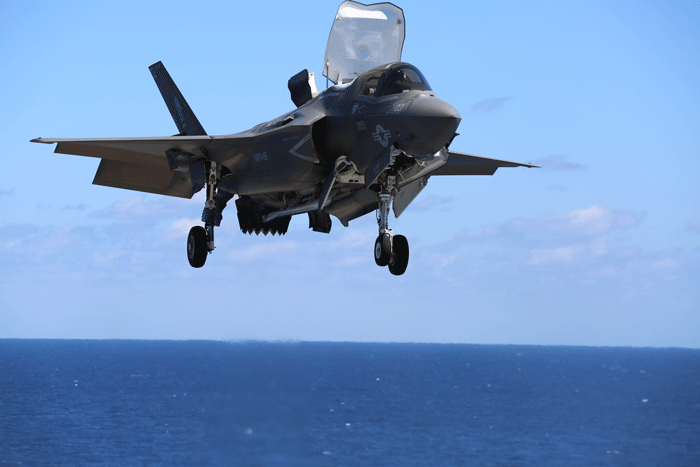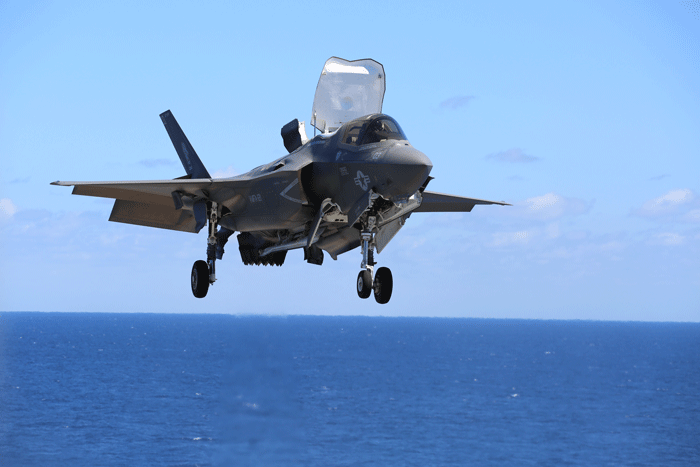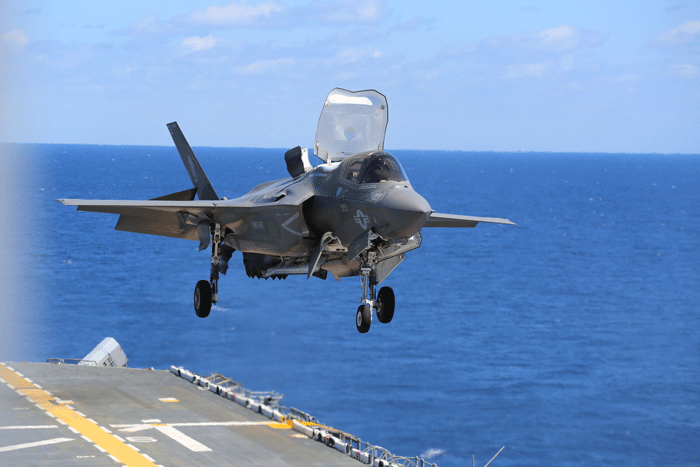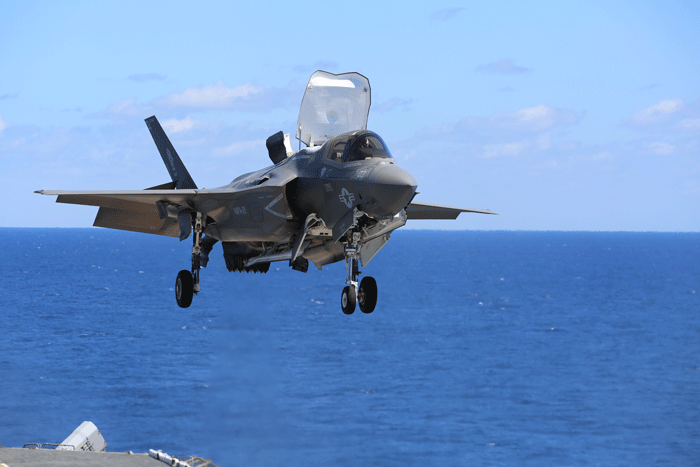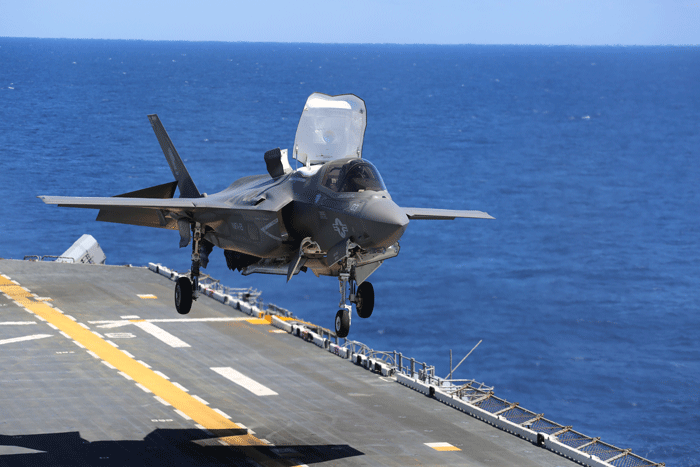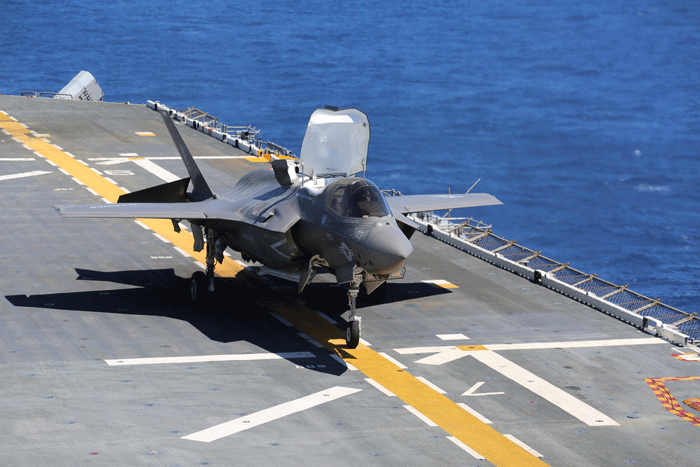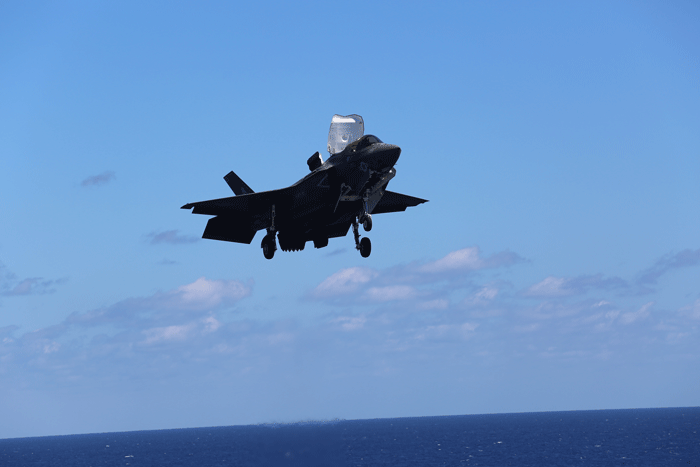2016-02-04 By Robbin Laird and Ed Timperlake
Pax River is the home of a key F-35 Integrated Test Force (ITF), which is focused on various aspects of the sea services F-35Bs and F-35Cs.
The ITF test regime is on the airframe, and flying characteristics in modes both symmetric and asymmetric, of the Lightning II.
Another F-35 test center is at Edwards AFB and is focused on expanding the flight envelope for the F-35A variant and verifying the capabilities of the mission systems and the fusion of information in the cockpit for the Lightning II force.
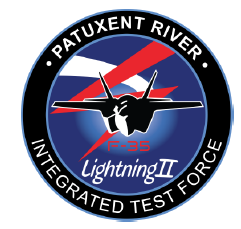
One of the most underappreciated aspects about the test program is how the concurrent learning among the various test centers provides enhanced confidence and accelerates testing with all T/M/S of this new aircraft.
The cross learning from the USMC F-35B, the service’s first T/M/S to achieve IOC, to the USAF F-35A to the USN F-35C model — with the preparation of the first RAF F-35B squadron — has meant that the USN can operate its Cs more rapidly and with more confidence and capability than in a traditional single-model aircraft test program.
The developmental testing across the board at Pax is converging on the emergence of an airplane that features excellent, handling qualities.
Every F-35 pilot interviewed by the Second Line of Defense team over the past few years has commented on the stable flight characteristics of the Lighting II. This was especially being proven in the most demanding and unforgiving combat flight requirements — carrier operations in all weather and sea sates.
It was noted that just like the USMC experience with F-35B, flight stability and control for safety and ease of a vertical landing, the same man-machine interface albeit different for Carrier arrested landings, is built into the F-35C.
Consequently, the prospects for reducing initial pilot training and requalification time for experienced Naval Aviators on the basics of safe landings and take-offs —with regard to both vertical and angled deck carrier flight ops —is a noteworthy accomplishment of the F-35 design.
This eventual reduction in required training for deck and carrier qualification means more flights can be used for tactical training.
An especially important impact maybe experienced with new pilots or “nuggets,” first tour aviators, who may have a safer basic training focus on landing and take-off requirements, requiring fewer hops because the aircraft is essentially easy to fly. If this is the case, then more expanded tactical training and operational time can be built into the Training & Readiness (T&R) syllabus within the same amount of resources required by an AV-8 or an F/A-18 just to learn and also stay current.
During our visit to Pax, we had a chance to discuss the test approach, test results and thinking about the way ahead with two key members of the ITF.
The first was with Tom Briggs, F-35 Pax River ITF Air Vehicle Engineering Department Head, who has more than 25 years of naval aviation test experience and has tested aircraft during 25 different at-sea detachments.
The second is CDR J. Ryan Murphy, the USN Director of Test and Evaluation, F-35 Naval Variants.
CDR Murphy is an F/A-18 pilot with significant operational experience — including command of Strike Fighter Squadron (VFA) 143 — and highlights the Navy approach for test pilots to come in and out of the operational community.
F-35C Arrested Landings Tests: November 2014 from SldInfo.com on Vimeo.
Question: From your perspective, how have you built synergy across the broader test community?
Briggs: An underappreciated reality is that the commonality of the aircraft allows the USAF and USN test communities to work closely together in shaping the way we test. Aircraft characteristics or anomalies, which the Air Force may see first at Edwards, we can leverage and vice versa.
We do a lot of information sharing with Edwards down at the individual team level. Our propulsion testers talk with their propulsion testers. Our weapons testers coordinate with their weapons testers. Our flying qualities folks talk with their flying qualities folks. So we understand what they have seen before we go into a similar line of testing and we share flight reports.
If there’s a problem that they see, we take a look at our data to see if we have something similar. If we start to see a problem, we let them know so that they can take a look as well.
Together we leverage our testing and ensure the other capitalizes on what we’ve found.
There’s a lot of that sharing that goes on, which frankly, for me, on a Navy test site to hear regularly from an Air Force test site is a little bit remarkable.
Together we make that work and we do our best to keep each other moving forward with our test programs.
And, that’s allowed us to take some very quick steps and very large steps during our testing.
If you take a look at the density of test points across the entire envelope versus a legacy flight test program, the F-35B and C testing is much thinner.
And, by the time the F-35A has done something, the F-35B test approach is less dense. And, by the time we do it on the C, it’s even less dense.
So the amount of data we need to gather for specification verification is markedly reduced by the time we’re doing it with the third variant.
The significant commonality built into the program allows for convergent ways to work the way ahead.
The electro-hydro static actuators, which work well on the A at 9Gs, work pretty well on the B and C at 7Gs.
In effect, instead of having three test programs, you have in effect something like a one and a half or twofold spread over the three variants.
And, when you look at Edwards, where the mission effectiveness testing is occurring, they fly different mixes and matches of aircraft, F-35Bs with F-35Cs and with F-35As. In a lot of cases, it’s two F-35As and an F-35B and F-35C in the mix.
So, the sensors, the communications back and forth between the aircraft, and the maturing of the software happens across multiple variants at the same time.
We are shaping joint operations from the ground up if the service cultures can embrace this change.
Question: Let us focus on the at-sea Developmental Testing done to date on the F-35C.
CDR Murphy, you came to Pax five months ago after your most recent operational deployment.
How would you characterize what we have seen and will see in the F-35C DT process?
CDR Murphy: For the C, when you look at DT-I, DT-II, DT-III, by and large, they are very similar to each other. What changes is aircraft, how we have the aircraft loaded.
DT-I was just the basic aircraft with no ordnance. For DT-II, we added internal stores. For DT-III, we’re going to have internal and external stores on the aircraft.
The testing you saw on DT-I and DT-II focused on the handling qualities behind the ship, landings with and without crosswind, launches with and without crosswinds, and minimum end speed catapult launches.
Those kinds of tests are going to be the same kind of tests we do on DT-III.
The difference will be that we are going to do them with a heavier aircraft with external stores.
Also, we’re not going to have a whole lot of fuel to play with because we’re carrying so much weight in ordnance.
Question: The handling qualities of the aircraft have been clearly noted by the pilots. What will be the impact of the performance gains by the aircraft in the hands of the operators?
Briggs: The flight control capabilities of the F-35 have already made it clear that the F-35B training burden should be much less than the Harrier, particularly in preparing pilots for recovery aboard ships; and with the approach handling qualities in the F-35C, there should also be less preparation required for shipboard landing with the F-35C versus the current F/A-18 platforms.
Carrier landings are demanding and require a great deal of training, with the pilot controlling the proper glide slope, line up and angle of attack.
With the F-35 control laws, the aircraft is dramatically assisting the pilot, and the pilot is now setting and monitoring the aircraft rather than controlling everything on the approach to the ship.
And, we will see how the new pilots — versus more experienced pilots — can benefit from these flight control capabilities built into the aircraft.
F-35C Night Ops from SldInfo.com on Vimeo.
CDR Murphy: We will see the real impacts as the airplane comes to the carrier deck.
The aircraft performs so well behind the boat, we could well see a reduction in training time with regard to flying the aircraft, especially around the carrier.
The key benefit is that as the amount of necessary training time to fly the aircraft goes down, the amount of available tactical training time goes up, which will be a significant gain for the fleet.
Question: The Navy is the last service to acquire the F-35 and has been widely perceived as dragging its feet and providing significant opposition to acquiring the aircraft.
Does this mean that the roll out of the culture changes (of the sort you are talking about) will see a slow cycle as well?
CDR Murphy: I do not think so.
There has been a barrage of literature out there, which has not always painted the aircraft in a favorable light, and our carrier pilots read that literature.
But, as the cadre of pilots grows and the aircraft makes its way to decks of carriers, you will see significant change rapidly.
We operate air wings; meaning that when a new air system comes to an air wing, the entire air wing is affected and its culture changed.
And, since the air wing trains together and deploys together, the F-35 will become ingrained as part of that air wing very rapidly.
Other Navy air wings will look at this experience and competitively seek to be as good or better than the last air wing that operated the F-35.
Peer pressure is a powerful learning tool.
Question: Although the F-35 represents a very new capability, it stands on the back of what has been done in the past, and harvests the results of significant work from before and operational achievements of earlier air systems.
How do you view this aspect of the learning curve?
Briggs: You have hit upon an important point.
The handling characteristics of the aircraft are unprecedented.
Its flight controls scheme and the amount of automation are re-shaping the pilot’s role, allowing them to focus on the tactical and strategic aspects of their mission, rather than on how they control the aircraft to be in the right part of the sky at the right time, or how they will recover aboard a pitching carrier at night.
We are where we are because the F-35 program has leveraged the development work of programs like the A-12 and the Navy’s MAGIC CARPET initiative, as well as the significant investments in risk reduction that were made early in the F-35 program.
The investments in risk reduction during the concept demonstration phase of the program and the final aircraft, which are now being built, has been significant.
And these investments are paying off in the robustness of the F-35B lift fan and propulsion system, in the precision of the flight control system, and other key elements that make this a very effective aircraft from a flying characteristic point of view.
Question: The Navy seems to rotate the test pilots here from operational squadrons into the test program.
How important is that?
CDR Murphy: Very important.
From a test perspective, having recent operational experience allows a test pilot to tie any aircraft deficiencies directly to the impact that deficiency might have on the mission.
When test pilots rotate back to the fleet, they take with them the knowledge and experience they have gained working on their particular program, in this case the F-35.
This provides a basis of knowledge in the fleet and assists in the introduction of the aircraft.
It’s amazing the difference between a Lieutenant or Lieutenant Commander test pilot traveling from Pax River to an operational air station and talking to people about the F-35 as opposed to even that same Lieutenant or Lieutenant Commander who is now a part of an operational squadron talking about flying the F-35.
To many young pilots who have not reached the end of their first operational tour, that operational Lieutenant or Lieutenant Commander has a lot more credibility as a squadron pilot than he did six months earlier when he came down from Pax River, even though it is the same person.
For the first piece published from our 2016 visit to Pax River, see the following:
https://sldinfo.com/the-emergence-of-the-f-35c-and-its-impact-the-view-from-pax-river/
Interviews done during our 2011 visit to Pax River:
https://sldinfo.com/fly-testing-the-f-35-a-building-block-approach/
https://sldinfo.com/the-f-35-mission-systems-a-game-changer-viewed-from-pax-river/
https://sldinfo.com/shaping-the-f-35-maintenance-approach/
https://sldinfo.com/an-update-on-f-35b-and-f35-c-testing/
https://sldinfo.com/the-f-35-pilot/
The slideshow highlights F-35B ship integration testing in May 2015.
The first video shows F-35C arrested landings aboard the USS Nimitz during DT-1 and is credited to the US Navy.
The second video shows U.S. Navy sailors conduct night flight operations with the F-35C Lightning II carrier variant joint strike fighter aboard USS Dwight D. Eisenhower (CVN 69).
The aircraft, assigned to the Salty Dogs of Air Test and Evaluation Squadron (VX 23), are aboard the aircraft carrier for the second phase of at-sea Developmental Testing (DT-II).
Credit: Navy Media Content Services:10/8/15


